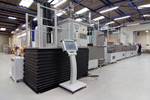Fibre Extrusion Technology contributes to sustainable composite solutions
FET’s range of laboratory and pilot melt spinning extrusion lines are suitable for process and end product development of sustainable materials.

This Sustainability Icon highlights FET’s commitment to sustainability through innovation and appears on all its promotional material. Photo Credit: Fibre Extrusion Technology
Fibre Extrusion Technology Ltd. (FET, Leeds, U.K.) reports further contribution to the field of sustainable textiles and processes with its range of laboratory and pilot melt spinning extrusion lines which are said to be ideally suited for both process and end product development of sustainable materials. More than 50 of these pilot and laboratory extrusion lines are operating successfully in the field, and it currently has orders for 8 further systems, FET says. Further, the company is currently engaged at the development stage with other clients all seeking innovative solutions for sustainable projects.
FET further contends that it has considerable experience in sustainable fiber development across a broad spectrum of industries including medical, textiles, consumables, agriculture and composites. The company says it has successfully processed almost 30 different polymer types in multifilament, monofilament and non-woven formats. The in-house Process Development Laboratory also enables vital client testing and evaluation throughout the experimental and development phases of every project.
FET adds that it continues to widen its scope in this field, collaborating with companies worldwide in order to promote greater sustainability through innovative manufacturing processes.
Related Content
-
Materials & Processes: Composites fibers and resins
Compared to legacy materials like steel, aluminum, iron and titanium, composites are still coming of age, and only just now are being better understood by design and manufacturing engineers. However, composites’ physical properties — combined with unbeatable light weight — make them undeniably attractive.
-
Materials & Processes: Fabrication methods
There are numerous methods for fabricating composite components. Selection of a method for a particular part, therefore, will depend on the materials, the part design and end-use or application. Here's a guide to selection.
-
Natural fiber composites: Growing to fit sustainability needs
Led by global and industry-wide sustainability goals, commercial interest in flax and hemp fiber-reinforced composites grows into higher-performance, higher-volume applications.













